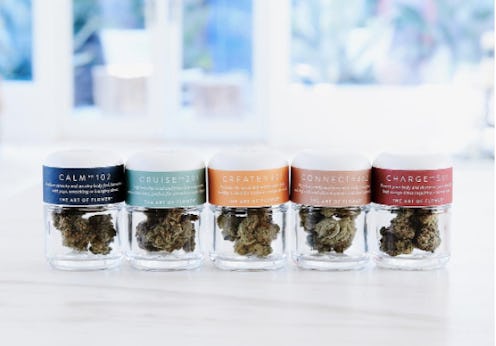Life
These Pot Strains Are Sold Based On Mood
Marijuana strains are known for their colorful monikers. Purple Urkle. Schnazzleberry. Alaskan Thunder Fuck. Girl Scout Cookies. Unless you’re a bud connoisseur however, these names don’t provide any information about the kind of high one can expect from smoking them, which means one second you’re laughing and taking a hit of Afgooey at a party and the next you’re sitting semi-comatose on the couch, unable to tear your eyes away from the paisley pattern on the throw pillows. Fortunately for experts and novices alike, California-based company Canndescent has developed an easy-to-navigate “effects-based classification system” that groups pot strains into five categories based on mood: Calm, Cruise, Create, Connect, and Charge.
The company classifies each of its strains into one of the five color-coded categories, and gives it a number as well as a series of tasting notes to let the user know what effect this strain could potentially have. It also suggests which activities would pair best with which high, like a sort of bud sommelier. For example, Calm no. 102 “Provides serenity and an airy body feel, perfect for yoga, stretching or lounging,” and Connect no. 402 “Blends a gentle euphoria with body relaxation, pairing well with dinner parties and small gatherings.”
Adrian Sedlin, the company’s CEO, argues that the traditional names of strains are no longer a good indicator of the product you’ll actually be getting. Different growers can grow the same strain indoors, outdoors, under glass, with or without pesticides, all of which affects the final product, and the high that follows.
“You shouldn’t need to bio-hack your body through a periodic table of ominous strain names like Durban Poison and Trainwreck just to buy some pot,” Canndescent’s CEO Adrian Sedlin said in a press release, “The way Apple made computing more intuitive and Google streamlined search, we want to democratize strain selection and provide users the opportunity to curate their life experience. Google asked, ‘What do you want to know?’ Canndescent asks, ‘How do you want to feel?’”
Canndescent uses liquid and gas chromatograph equipment to categorize its twenty-four strains based on their cannabinoid profiles and terpene (what gives each strain its scent and taste). The company’s website — which looks like the website for a fancy spa in Aspen where you might run accidentally bump into Gwyneth Paltrow — provides detailed analytics of each strain, including information on its thirteen chemical characteristics like THC Potential and Total Active Cannabinoids.
As precise as their measurements are, Canndescent’s guidelines are not guarantees; every body responds to cannabis differently. The exact effects of pot are also difficult to study in a clinical setting; because it’s a schedule-1 narcotic, it’s almost impossible to conduct clinical trials. Canndescent is hoping to work around this by developing an app that allows users to log their experiences with different strains.
“It’s not this mysterious cannabis thing,” Sedlin said, “It’s ‘OK, this is going to make me a little more tired and I’ll go to sleep for the night,’ or ‘This one’s more for going out at night — I can relate to that.’”
The company hopes that standardizing marijuana and making it more accessible and easy to understand for the general public will help normalize its use. As of now, 29 states have legalized marijuana in some form.
